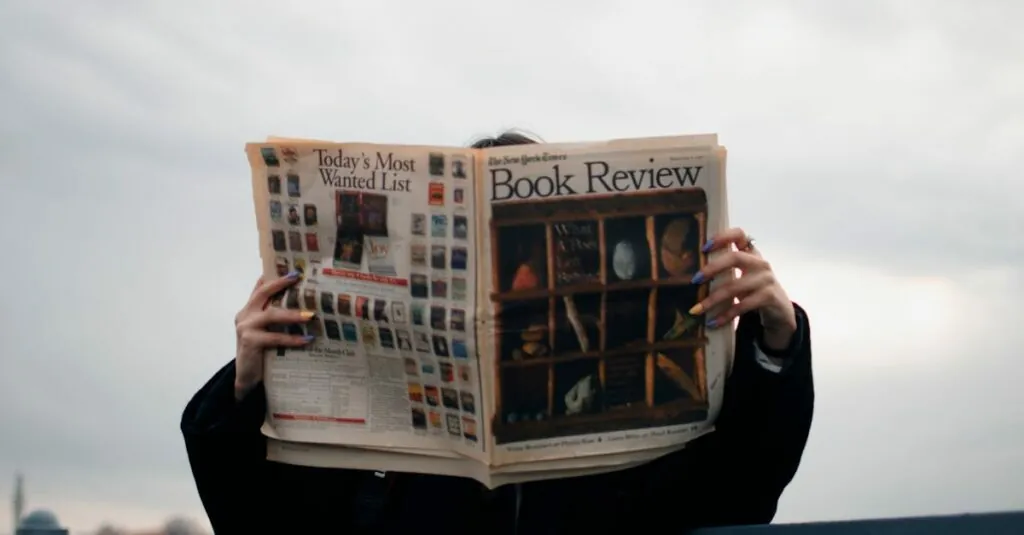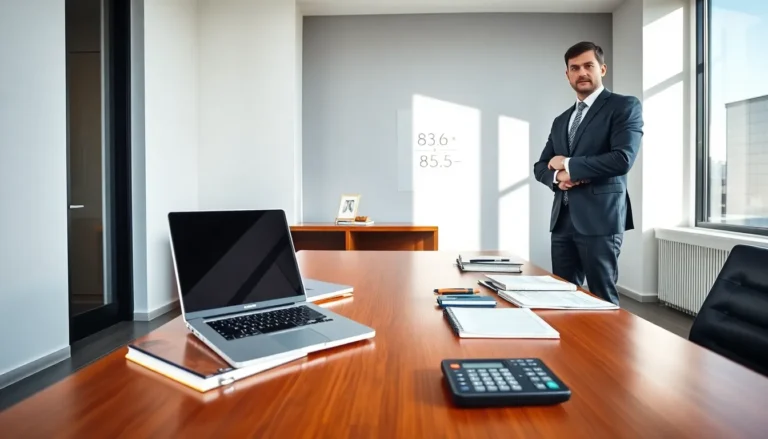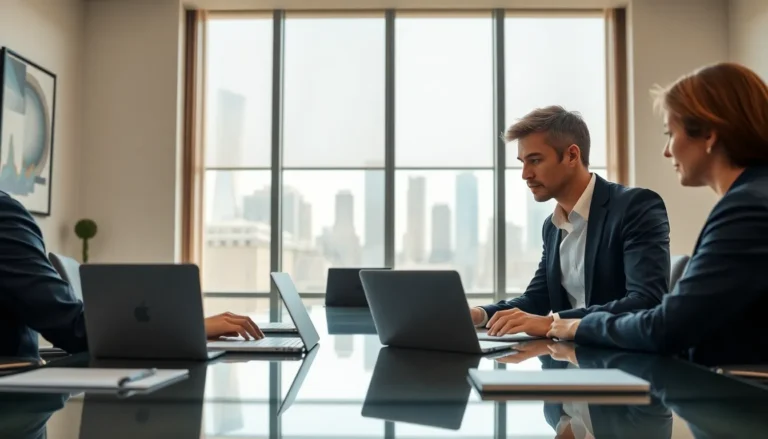In a world where sweatpants once ruled the office, business casual has undergone a transformation that’s both stylish and practical. Gone are the days of stuffy blazers and awkward ties. Today’s workplace attire embraces comfort without sacrificing professionalism. It’s like finding the perfect balance between a boardroom-ready look and your favorite weekend outfit—who knew that was possible?
Table of Contents
ToggleWhat Is Business Casual?
Business casual attire represents a relaxed yet professional dress code in the workplace. This style often incorporates elements of both formal and casual clothing, creating a balance that conveys professionalism while prioritizing comfort. Standard pieces include dress shirts, blouses, chinos, skirts, and closed-toe shoes. Defined by its versatility, business casual allows employees to express personal styles without compromising professionalism.
Certain guidelines help maintain a polished appearance. For men, options like tailored trousers and collared shirts often work well. Women may wear slacks or knee-length dresses alongside cardigans or blazers. Denim can occasionally fit into this dress code, provided it remains free of rips and is paired with appropriate tops.
Accessories also play a crucial role in defining business casual looks. Simple jewelry and structured bags can enhance overall presentation without overwhelming it. Colors and patterns may vary, but sticking to muted tones typically aligns better with office environments. Footwear adds another layer, as loafers, flats, and conservative heels usually fit the bill.
Company culture influences interpretations of business casual, leading to variations across different industries. Tech firms might embrace a more relaxed version, with jeans and sneakers being commonplace. In contrast, financial institutions often maintain stricter interpretations emphasizing conservative styles.
Key to understanding business casual lies in recognizing its adaptability and context. Adopting this attire signals an awareness of workplace dynamics while fostering a culture of comfort and productivity. Overall, business casual promotes an atmosphere that supports creativity and professionalism simultaneously.
Evolution of Business Casual
Business casual attire has undergone significant changes over the years, shifting toward a style that balances comfort and professionalism. This evolution reflects broader societal trends in communication and workplace culture.
Historical Context
In the past, office wear involved strict adherence to formal styles. Traditional suits, ties, and dresses dominated the workplace. This rigidity began to loosen in the late 20th century as workplace environments transformed. Many companies started promoting comfort to improve employee morale and productivity. By the 1980s, business casual emerged as a more relaxed option, particularly in industries with creative elements. It allowed employees to express individuality while still maintaining a professional image.
Modern Interpretations
Today, interpretations of business casual vary widely across sectors. Tech companies often favor relaxed attire, emphasizing functionality and individual expression. Financial institutions typically uphold more conservative standards, ensuring attire reflects their professional image. This adaptability showcases the diverse nature of workplace environments, allowing employees to choose clothing that resonates with their company culture. Dress code guidelines now encompass a range of options, enabling employees to balance personal taste with professionalism seamlessly.
Key Trends in Business Casual Updates
Current business casual attire reflects a blend of comfort and professionalism. As dress codes evolve, key trends continue to emerge within this dynamic style.
Popular Fabrics and Materials
Cotton remains a staple for business casual clothing. It provides breathability and ease, often found in dress shirts and blouses. Polyester blends offer durability and maintain a polished appearance, making them popular for trousers and skirts. Wool, lightweight and versatile, is increasingly favored in spring and fall apparel. These fabrics meet the comfort needs of employees while retaining a professional look. Additionally, the use of sustainable materials has gained traction, aligning with environmentally-conscious business practices.
Color Palettes and Patterns
Neutral tones dominate popular color choices, with shades like navy, gray, and beige easily paired with various outfits. Pastels also find favor as a warmer alternative, offering options for brightening wardrobes. Patterns such as subtle plaids, stripes, and florals add visual interest without overwhelming a professional appearance. Mixing and matching these colors and patterns enhances personal style, allowing personalization within the boundaries of business casual. Ultimately, this focus on coordinated color palettes strengthens the sophisticated image that businesses aim to maintain.
How to Implement Business Casual Updates in Your Wardrobe
Integrating business casual updates into a wardrobe involves selecting key pieces that blend professionalism with comfort. Knowing what to include helps maintain an appropriate appearance.
Essential Pieces for Men
Collared shirts tailored to fit provide a polished look without sacrificing comfort. Trousers in neutral colors like navy or gray complement these shirts while enhancing flexibility. Chinos serve as a versatile alternative, offering a relaxed fit that still appears professional. Closed-toe shoes, such as loafers or brogues, complete the outfit, ensuring that footwear aligns with the business casual standard. Accessories, including a simple watch or belt, can elevate the overall appearance and reflect personal style.
Essential Pieces for Women
Blouses made from breathable fabrics add sophistication and comfort to a business casual wardrobe. Pairing these blouses with tailored slacks or knee-length skirts maintains a professional silhouette. Dresses that feature subtle patterns or muted colors also work well within this dress code, offering an effortless yet polished look. Footwear choices like low-heeled pumps or stylish flats ensure both professionalism and comfort. Incorporating accessories, such as understated jewelry or scarves, can enhance personal expression without detracting from the overall professional appearance.
Tips for Maintaining a Professional Look
Dress appropriately to fit the business casual standard, which merges comfort with professionalism. Choose polished pieces like tailored trousers and collared shirts for men. Opt for blouses and knee-length skirts or slacks for women, favoring breathable fabrics.
Select shoes that are closed-toe, ensuring a neat appearance. Accessories should remain minimal and understated, adding a subtle touch without overpowering the outfit. Prioritize neutral colors, with navy, gray, and beige making strong foundations. Add visual interest through pastels or simple patterns, keeping the overall look professional.
Maintain well-fitted clothing; oversized or ill-fitting garments detract from a polished appearance. When layering, choose lightweight pieces to ensure comfort throughout the day. Ensure that all items are clean and wrinkle-free, achieving an overall tidy look.
Consider the company culture, as business casual interpretations may vary. Research how peers dress and adapt accordingly, striking a balance between individual style and workplace expectations. Tailor personal expression while adhering to the collective standard, supporting an atmosphere of professionalism and creativity.
Stay updated on current trends as styles evolve. Incorporate sustainable materials when possible, reflecting modern values while enhancing a sophisticated image. By following these guidelines, individuals convey confidence and professionalism in a casual setting.
The evolution of business casual attire reflects a significant shift in workplace culture. It’s not just about comfort; it’s about striking a balance between personal expression and professionalism. As companies continue to adapt their dress codes, employees can confidently embrace styles that resonate with their individuality while adhering to their organization’s standards.
By understanding the nuances of business casual, individuals can navigate their wardrobe choices effectively. Incorporating key pieces and staying mindful of company culture allows for a polished appearance that fosters both creativity and professionalism. This adaptability ultimately enhances the workplace environment, making it more enjoyable and productive for everyone involved.




